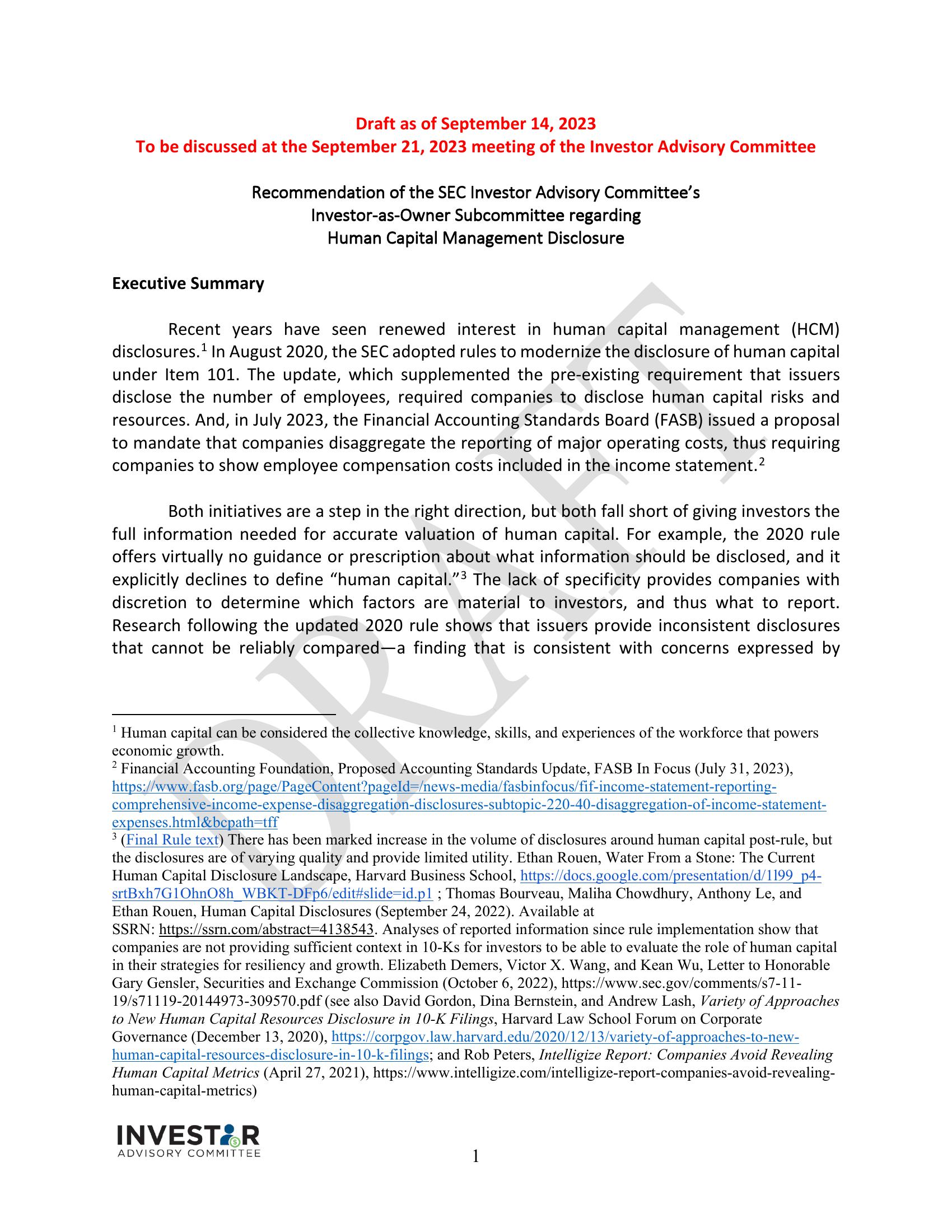Workforce Data Insight Pitch
Draft as of September 14, 2023
To be discussed at the September 21, 2023 meeting of the Investor Advisory Committee
Recommendation of the SEC Investor Advisory Committee's
Investor-as-Owner Subcommittee regarding
Human Capital Management Disclosure
Executive Summary
Recent years have seen renewed interest in human capital management (HCM)
disclosures.¹ In August 2020, the SEC adopted rules to modernize the disclosure of human capital
under Item 101. The update, which supplemented the pre-existing requirement that issuers
disclose the number of employees, required companies to disclose human capital risks and
resources. And, in July 2023, the Financial Accounting Standards Board (FASB) issued a proposal
to mandate that companies disaggregate the reporting of major operating costs, thus requiring
companies to show employee compensation costs included in the income statement.²
Both initiatives are a step in the right direction, but both fall short of giving investors the
full information needed for accurate valuation of human capital. For example, the 2020 rule
offers virtually no guidance or prescription about what information should be disclosed, and it
explicitly declines to define “human capital.”³ The lack of specificity provides companies with
discretion to determine which factors are material to investors, and thus what to report.
Research following the updated 2020 rule shows that issuers provide inconsistent disclosures
that cannot be reliably compared-a finding that is consistent with concerns expressed by
¹ Human capital can be considered the collective knowledge, skills, and experiences of the workforce that powers
economic growth.
² Financial Accounting Foundation, Proposed Accounting Standards Update, FASB In Focus (July 31, 2023),
https://www.fasb.org/page/PageContent?pageId=/news-media/fasbinfocus/fif-income-statement-reporting-
comprehensive-income-expense-disaggregation-disclosures-subtopic-220-40-disaggregation-of-income-statement-
expenses.html&bcpath=tff
3 (Final Rule text) There has been marked increase in the volume of disclosures around human capital post-rule, but
the disclosures are of varying quality and provide limited utility. Ethan Rouen, Water From a Stone: The Current
Human Capital Disclosure Landscape, Harvard Business School, https://docs.google.com/presentation/d/1199 p4-
srtBxh7G1Ohn08h_WBKT-DFp6/edit#slide-id.pl ; Thomas Bourveau, Maliha Chowdhury, Anthony Le, and
Ethan Rouen, Human Capital Disclosures (September 24, 2022). Available at
SSRN: https://ssrn.com/abstract=4138543. Analyses of reported information since rule implementation show that
companies are not providing sufficient context in 10-Ks for investors to be able to evaluate the role of human capital
in their strategies for resiliency and growth. Elizabeth Demers, Victor X. Wang, and Kean Wu, Letter to Honorable
Gary Gensler, Securities and Exchange Commission (October 6, 2022), https://www.sec.gov/comments/s7-11-
19/s71119-20144973-309570.pdf (see also David Gordon, Dina Bernstein, and Andrew Lash, Variety of Approaches
to New Human Capital Resources Disclosure in 10-K Filings, Harvard Law School Forum on Corporate
Governance (December 13, 2020), https://corpgov.law.harvard.edu/2020/12/13/variety-of-approaches-to-new-
human-capital-resources-disclosure-in-10-k-filings; and Rob Peters, Intelligize Report: Companies Avoid Revealing
Human Capital Metrics (April 27, 2021), https://www.intelligize.com/intelligize-report-companies-avoid-revealing-
human-capital-metrics)
INVESTOR
ADVISORY COMMITTEE
1View entire presentation